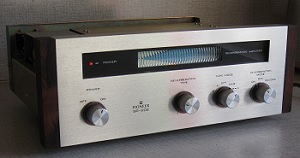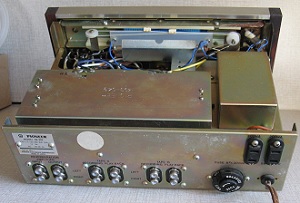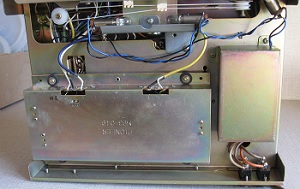Vintage Audio: Pioneer SR-202 Spring Reverb | Telos Alliance
By The Telos Alliance Team on Jul 1, 2014 4:00:00 PM
 Vintage Tech: Pioneer SR-202 Spring Reverb
Vintage Tech: Pioneer SR-202 Spring Reverb
From the earliest days of high fidelity in the 1930s, the goal of equipment designers was to create a listening experience almost like having a front-row seat in a concert hall. As technology evolved, frequency response was extended to the theoretical limits, noise and distortion were reduced, and recording technologies were improved. Another avenue for recreating a live listening experience is reverberation; this month's Found in the Attic looks at a 1971 Pioneer SR-202 spring reverb.
The SR-202 is a simple device, with just 10 transistors and 2 diodes. Power is supplied by a 25-volt regulated supply. A conventional 5-transistor amp connects to line in and out. A drive amp, consisting of 4 transistors, boosts the signal going into the spring reverb enclosure.
In a typical stereo system, the 202 is installed in the amplifier's tape monitor circuit, taking unprocessed sound from the 'tape in' connector, and delivering reverb-enhanced sound back to the amp through the 'tape out' connectors. The 202 also provided two sets of tape monitor connectors on the rear, enabling material to be recorded with reverb on two tape machines.
From zero to 2.5 seconds of reverb can be selected by the front-panel knob, and on the illuminated display, a blue diamond grows in length as the amount of reverb is increased. This is one of those displays which is not really practical or necessary, but adds to the coolness of the unit.
There are several ways to create reverberation. One of the earliest was echo chambers. Basically, a loudspeaker was placed at one end of a long hallway, and a microphone at the other. This scheme was occasionally used in radio stations during the early days. The disadvantage was that it took up a lot of floor space, and it was difficult to vary the reverb time.
Plate reverberators were a huge improvement, as many of the reverb characteristics could be controlled. Here, a transducer which is similar to a loudspeaker is placed in close proximity to a steel plate. A pickup captures the vibrations from the plate and that is the audio output. These plate devices brought reverberation to many recording studios. Most memorable was the EMT 140, a large and expensive device. Many of the Beatles’ later records recorded in Abbey Road Studios employed the EMT 140.
Spring reverbs, such as the Pioneer SR-202 were compact and less expensive than plate reverbs, and these were what brought the effect to consumer electronics. They are similar to plate reverbs in that there is a transducer on one end and a pickup on the other. The main difference is that the transducer vibrates a spring.
A few radio stations used spring reverbs in the ‘40s and ‘50s to enhance the playback of concert hall recordings, and a few of us remember nickel tours of radio stations where we were taken to see the 'spring room', which was usually no longer functional.
Much later, AKG introduced the BX family of spring reverbs, with long springs encased in a vertical tower. A few found their way into major market stations, but everyone else wound up adapting unbalanced consumer units to the broadcast environment. In addition to their use for special effects in the production room, spring reverbs were sometimes put in the mic channel of the on-air studio, particularly in Top 40 stations, giving that unmistakable 'boss jock' sound.
Like everything else, reverberation was changed by the advent of digital techniques. Starting in the ‘90s, companies such as Yamaha introduced digital reverbs which had a library of digital reverb algorithms, as well as presets. Most used multiple feedback delay circuits to create cavern-like echoes. By simulating the time and frequency domain of rooms based on dimensions and absorption characteristics of the walls, they can simulate the acoustic properties of practically any space.
 Today, with more advanced algorithms and LSI construction techniques, reverb is built into the effects library of most digital audio workstations.
Today, with more advanced algorithms and LSI construction techniques, reverb is built into the effects library of most digital audio workstations.
This SR-202 was a thrift store purchase, costing the princely sum of $1.99. It is in excellent shape physically, and working well. It is part of a vintage Pioneer sound system, and used to good effect in a large living room. Replacement of the original electrolytic capacitors is one more project on the infinite to-do list.
Telos Alliance has led the audio industry’s innovation in Broadcast Audio, Digital Mixing & Mastering, Audio Processors & Compression, Broadcast Mixing Consoles, Audio Interfaces, AoIP & VoIP for over three decades. The Telos Alliance family of products include Telos® Systems, Omnia® Audio, Axia® Audio, Linear Acoustic®, 25-Seven® Systems, Minnetonka™ Audio and Jünger Audio. Covering all ranges of Audio Applications for Radio & Television from Telos Infinity IP Intercom Systems, Jünger Audio AIXpressor Audio Processor, Omnia 11 Radio Processors, Axia Networked Quasar Broadcast Mixing Consoles and Linear Acoustic AMS Audio Quality Loudness Monitoring and 25-Seven TVC-15 Watermark Analyzer & Monitor. Telos Alliance offers audio solutions for any and every Radio, Television, Live Events, Podcast & Live Streaming Studio With Telos Alliance “Broadcast Without Limits.”
Recent Posts
Subscribe
If you love broadcast audio, you'll love Telos Alliance's newsletter. Get it delivered to your inbox by subscribing below!